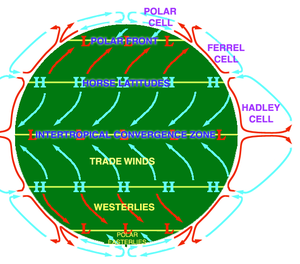

The troposphere is the lowest layer of the atmosphere of Earth. It contains 80% of the total mass of the planetary atmosphere and 99% of the total mass of water vapor and aerosols, and is where most weather phenomena occur.[1] From the planetary surface of the Earth, the average height of the troposphere is 18 km (11 mi; 59,000 ft) in the tropics; 17 km (11 mi; 56,000 ft) in the middle latitudes; and 6 km (3.7 mi; 20,000 ft) in the high latitudes of the polar regions in winter; thus the average height of the troposphere is 13 km (8.1 mi; 43,000 ft).
The term troposphere derives from the Greek words tropos (rotating) and sphaira (sphere) indicating that rotational turbulence mixes the layers of air and so determines the structure and the phenomena of the troposphere.[2] The rotational friction of the troposphere against the planetary surface affects the flow of the air, and so forms the planetary boundary layer (PBL) that varies in height from hundreds of meters up to 2 km (1.2 mi; 6,600 ft). The measures of the PBL vary according to the latitude, the landform, and the time of day when the meteorological measurement is realized. Atop the troposphere is the tropopause, which is the functional atmospheric border that demarcates the troposphere from the stratosphere. As such, because the tropopause is an inversion layer in which air-temperature increases with altitude, the temperature of the tropopause remains constant.[2] The layer has the largest concentration of nitrogen.

(i) the exosphere at 600+ km;
(ii) the thermosphere at 600 km;
(iii) the mesosphere at 95–120 km;
(iv) the stratosphere at 50–60 km; and
(v) the troposphere at 8–15 km.
The distance from the planetary surface to the edge of the stratosphere is ±50 km, less than 1.0% of the radius of the Earth.